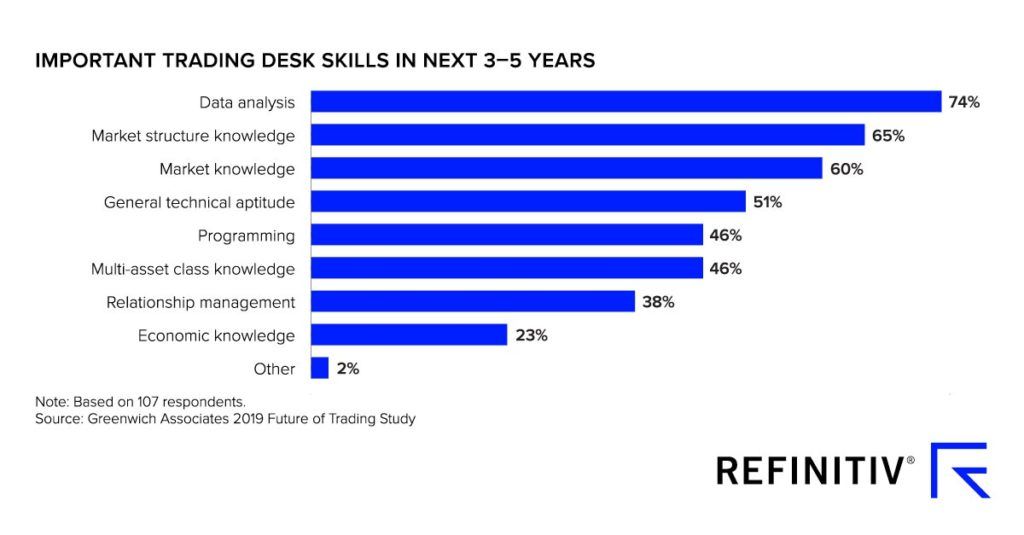Data Storytelling with Augmented Analytics

Traditionally, traders have had to retrieve and review information from data terminals manually, scouring reams of information for various signals from which to draw their own conclusions. With augmented analytics, this workload is handled for them, providing pre-trade actionable insights in minutes, not hours.
Harnessing the full potential of analytics entails more than just knowledge discovery; it’s about uncovering insights that lead decision-makers to take action. According to Gartner, by 2025, data stories will be the most widespread way of consuming analytics, and 75 percent of stories will be automatically generated using augmented analytics techniques.
Investment firms have vast reams of business data at their disposal, which, on the surface, is great. But mining this seemingly bottomless pool of information in search of actionable insights is a different story.
To overcome hurdles with data literacy, smart companies have embraced various business intelligence solutions to collect, aggregate, translate and present business information. An invaluable asset for enterprises worldwide, business intelligence (BI) dashboards are data visualization tools that display the status of business analytics metrics, key performance indicators (KPIs) and other important data points on a single screen.
To underscore the widespread adoption of BI, note that the global business intelligence market is projected to reach USD $147.19 billion by 2025.
For many firms, visualizations alone cannot tell data’s full story. Actionable intelligence requires the combination of interactive data visualization with written and/or spoken narratives. These hybrid techniques deliver insights in a compelling, easily understood form for presentation to a broad base of decision makers.
This disparity in functionality between traditional and next-gen data resources is fueling the growing demand for augment analytics.
A key enabler for augmented analytics is natural language generation (NLG), a form of artificial intelligence (AI) that automates the analysis and interpretation of all underlying structured data at scale to uncover and communicate insights in everyday, human language.
NLG augments data visualizations in TIBCO Spotfire, Tableau, Microsoft Power BI, Microsoft Excel, MicroStrategy, and other tools with explanatory narratives – analyses that drill down into structured data and uncover actionable insights faster. This results in more informed decision-making as users see insights they may otherwise have missed or misunderstood.
NLG’s ability to deliver on-demand, objective insights on business performance is a legitimate game-changer for financial and investment professionals. In addition to producing actionable intelligence, narratives communicate the full story of your data.
What else can you do with NLG?
- Report on data that isn’t even visualized on the dashboard—if it’s in your dataset, you can bring a discussion of it into your report.
- Ensure critical facts and insights that otherwise would be missed are now shown.
- Tell a fully contextualized story, in natural language, going well beyond visualizations alone.
- Easily create on-demand, consistent, data-driven stories for improved data literacy.
Companies such as Arria NLG, a global provider of artificial intelligence technology that was founded in conjunction with data scientists from University of Aberdeen, enable top financial institutions worldwide to harness actionable insights from data.
“For data to have value, enterprises must be able to extract meaningful insights that lead to positive business outcomes,” said Sharon Daniels, CEO of Arria NLG.

Generated in near real time with a simple click of the button, natural language narratives extend the reach and value of analytics by automatically analyzing structured data from spreadsheets, JSON files, or entire datasets underlying business intelligence dashboards, creating substantive, knowledge-driven narratives that affect corporate strategy.
For institutional investors and capital markets professionals, augmented analytics can provide explanatory insights to support more informed trading decisions. Natural Language Generation AI mines all underlying data from BI dashboards, Excel spreadsheets, etc., connecting the dots to present insightful narratives in real time that lets traders leverage terabytes of information to their advantage.
Traditionally, traders have had to retrieve and review information from data terminals manually, looking for various signals from which to draw their own conclusions. With augmented analytics, this workload is handled for them, providing pre-trade actionable insights in minutes, not hours.
Augmented analytics also amplify the effectiveness of fund analysis, enabling investment institutions to convey the contributing factors affecting portfolio performance to shareholders.
Advanced NLG narratives are not regurgitated summaries; analyses highlight the factors driving stock prices up, or the reasons why share prices have declined. This clarity provides customers with up-to-date information on the current positioning of their funds and uses simplified narratives to expose them to key analytics.
In other words, NLG doesn’t just explain what happened – but why it happened.
Augmented analytics expand the population of employees that can use BI tools to find, extract and understand potentially actionable and useful insights from data, which are otherwise hidden in a conglomeration of statistics and information scattered across disparate spreadsheets and data warehouses.
Complementing data visualizations with explanatory narratives also removes ambiguity and the potential for conflicting interpretations of findings.
“Adding contextual analyses that support conclusions presented in visualizations increases organizational understanding and data literacy, and multiplies return on investments in data analytics,” added Daniels.
Advancements in data and technology are shifting the paradigm of how investment professionals harness data to gain a competitive advantage. If knowledge is power, augmented analytics and data storytelling amplify its flow, providing on-demand access to actionable insights.